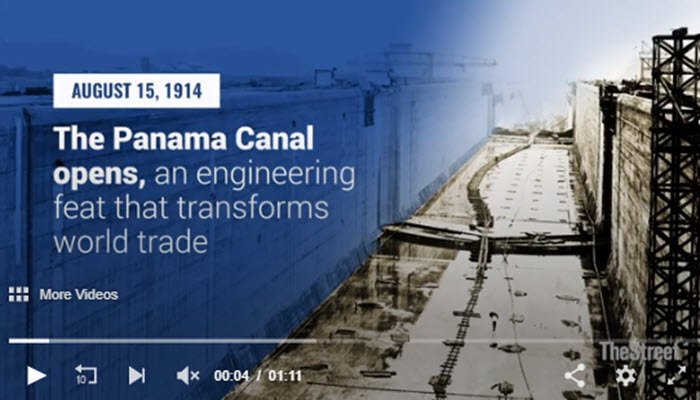In August 15, 1914, the Panama Canal opened, an engineering feat that would transform world trade. It is one of the two most strategic artificial waterways in the world, the other being the Suez Canal.
In the 1800s, American and British leaders and businessmen wanted to ship goods quickly and cheaply between the Atlantic and Pacific coasts. Earlier French attempts to build a canal through Panama resulted in failure due to illness and lack of funds.
U.S. President Theodore Roosevelt supported the project so enthusiastically that he was universally thought of as the “father” of the canal.
The 1901 Hay-Pauncefote Treaty allowed the U.S. to build and manage its own canal in Columbian South America. In 1903, Panama provided the U.S. with a 10-mile wide strip of land for the canal for a $10 million one-time payment and payments of $250,000 per year.
Engineer John Frank Stevens designed a lock-type canal and a dam that would create the largest artificial lake in the world at the time. Ships sailing between the east and west coasts of the U.S. would shorten their voyage by 8,000 nautical miles.
In August 15, 1914, the Panama Canal opened, an engineering feat that would transform world trade. It is one of the two most strategic artificial waterways in the world, the other being the Suez Canal.
In the 1800s, American and British leaders and businessmen wanted to ship goods quickly and cheaply between the Atlantic and Pacific coasts. Earlier French attempts to build a canal through Panama resulted in failure due to illness and lack of funds.
U.S. President Theodore Roosevelt supported the project so enthusiastically that he was universally thought of as the “father” of the canal.
The 1901 Hay-Pauncefote Treaty allowed the U.S. to build and manage its own canal in Columbian South America. In 1903, Panama provided the U.S. with a 10-mile wide strip of land for the canal for a $10 million one-time payment and payments of $250,000 per year.
Engineer John Frank Stevens designed a lock-type canal and a dam that would create the largest artificial lake in the world at the time. Ships sailing between the east and west coasts of the U.S. would shorten their voyage by 8,000 nautical miles.
A 1979 treaty returned control of the area to Panama by 1999 and confirmed the neutrality of Panama’s control over the canal.
Today, trade between the east coast of the United States and East Asia dominates international canal traffic. It takes 11.38 hours to pass through the canal; principle transports are motor vehicles, petroleum products, grains, and coal.
The American Society of Civil Engineers has named the Panama Canal one of the seven wonders of the modern world.
Stay Safe!!
